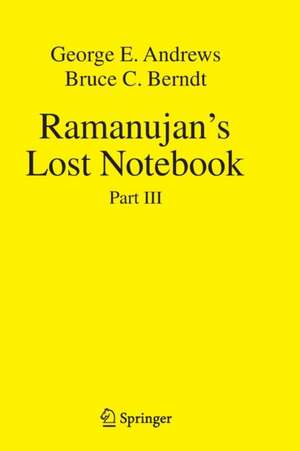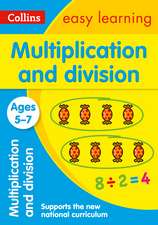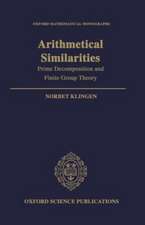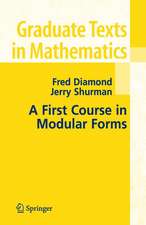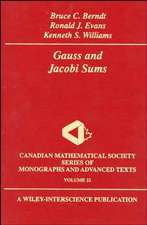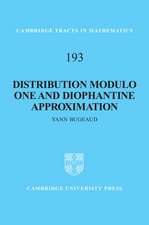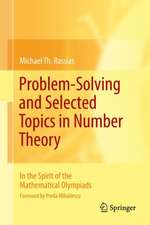Ramanujan's Lost Notebook: Part III
Autor George E. Andrews, Bruce C. Berndten Limba Engleză Paperback – 17 iul 2014
This volume is the third of five volumes that the authors plan to write on Ramanujan’s lost notebook and other manuscripts and fragments found in The Lost Notebook and Other Unpublished Papers, published by Narosa in 1988. The ordinary partition function p(n) is the focus of this third volume. In particular, ranks, cranks, and congruences for p(n) are in the spotlight. Other topics include the Ramanujan tau-function, the Rogers–Ramanujan functions, highly composite numbers, and sums of powers of theta functions.
Review from the second volume:
"Fans of Ramanujan's mathematics are sure to be delighted by this book. While some of the content is taken directly from published papers, most chapters contain new material and some previously published proofs have been improved. Many entries are just begging for further study and will undoubtedly be inspiring research for decades to come. The next installment in this series is eagerly awaited."
- MathSciNet
Review from the first volume:
"Andrews a
nd Berndt are to be congratulated on the job they are doing. This is the first step...on the way to an understanding of the work of the genius Ramanujan. It should act as an inspiration to future generations of mathematicians to tackle a job that will never be complete."
- Gazette of the Australian Mathematical Society
| Toate formatele și edițiile | Preț | Express |
|---|---|---|
| Paperback (5) | 649.06 lei 43-57 zile | |
| Springer – 29 oct 2010 | 649.06 lei 43-57 zile | |
| Springer – 30 sep 2010 | 790.57 lei 43-57 zile | |
| Springer International Publishing – 26 dec 2018 | 899.06 lei 43-57 zile | |
| Springer – 7 iul 2015 | 952.26 lei 43-57 zile | |
| Springer – 17 iul 2014 | 953.72 lei 43-57 zile | |
| Hardback (5) | 828.56 lei 43-57 zile | |
| Springer – 6 mai 2005 | 828.56 lei 43-57 zile | |
| Springer – 23 dec 2008 | 900.80 lei 43-57 zile | |
| Springer International Publishing – 18 sep 2018 | 904.35 lei 43-57 zile | |
| Springer – 11 iun 2012 | 957.62 lei 43-57 zile | |
| Springer – 4 iun 2013 | 958.38 lei 43-57 zile |
Preț: 953.72 lei
Preț vechi: 1163.06 lei
-18% Nou
Puncte Express: 1431
Preț estimativ în valută:
182.55€ • 198.36$ • 153.44£
182.55€ • 198.36$ • 153.44£
Carte tipărită la comandă
Livrare economică 21 aprilie-05 mai
Preluare comenzi: 021 569.72.76
Specificații
ISBN-13: 9781489994974
ISBN-10: 1489994971
Pagini: 448
Ilustrații: XII, 436 p.
Dimensiuni: 155 x 235 x 24 mm
Greutate: 0.68 kg
Ediția:2012
Editura: Springer
Colecția Springer
Locul publicării:New York, NY, United States
ISBN-10: 1489994971
Pagini: 448
Ilustrații: XII, 436 p.
Dimensiuni: 155 x 235 x 24 mm
Greutate: 0.68 kg
Ediția:2012
Editura: Springer
Colecția Springer
Locul publicării:New York, NY, United States
Public țintă
ResearchDescriere
In the spring of 1976, George Andrews of Pennsylvania State University visited the library at Trinity College, Cambridge to examine the papers of the late G.N. Watson. Among these papers, Andrews discovered a sheaf of 138 pages in the handwriting of Srinivasa Ramanujan. This manuscript was soon designated, "Ramanujan's lost notebook." Its discovery has frequently been deemed the mathematical equivalent of finding Beethoven's tenth symphony.
This volume is the third of five volumes that the authors plan to write on Ramanujan’s lost notebook and other manuscripts and fragments found in The Lost Notebook and Other Unpublished Papers, published by Narosa in 1988. The ordinary partition function p(n) is the focus of this third volume. In particular, ranks, cranks, and congruences for p(n) are in the spotlight. Other topics include the Ramanujan tau-function, the Rogers–Ramanujan functions, highly composite numbers, and sums of powers of theta functions.
Review from the second volume:
"Fans of Ramanujan's mathematics are sure to be delighted by this book. While some of the content is taken directly from published papers, most chapters contain new material and some previously published proofs have been improved. Many entries are just begging for further study and will undoubtedly be inspiring research for decades to come. The next installment in this series is eagerly awaited."
- MathSciNet
Review from the first volume:
"Andrews and Berndt are to be congratulated on the job they are doing. This is the first step...on the way to an understanding of the work of the genius Ramanujan. It should act as an inspiration to future generations of mathematicians to tackle a job that will never be complete."
- Gazette of the Australian Mathematical Society
This volume is the third of five volumes that the authors plan to write on Ramanujan’s lost notebook and other manuscripts and fragments found in The Lost Notebook and Other Unpublished Papers, published by Narosa in 1988. The ordinary partition function p(n) is the focus of this third volume. In particular, ranks, cranks, and congruences for p(n) are in the spotlight. Other topics include the Ramanujan tau-function, the Rogers–Ramanujan functions, highly composite numbers, and sums of powers of theta functions.
Review from the second volume:
"Fans of Ramanujan's mathematics are sure to be delighted by this book. While some of the content is taken directly from published papers, most chapters contain new material and some previously published proofs have been improved. Many entries are just begging for further study and will undoubtedly be inspiring research for decades to come. The next installment in this series is eagerly awaited."
- MathSciNet
Review from the first volume:
"Andrews and Berndt are to be congratulated on the job they are doing. This is the first step...on the way to an understanding of the work of the genius Ramanujan. It should act as an inspiration to future generations of mathematicians to tackle a job that will never be complete."
- Gazette of the Australian Mathematical Society
Cuprins
Preface.- Introduction.- 1. Ranks and Cranks, Part I.- 2. Ranks and Cranks, Part II.- 3. Ranks and Cranks, Part III.- 4. Ramanujan's Unpublished Manuscript on the Partition and Tau Functions.- 5. Theorems about the Partition Function on Pages 189 and 182.- 6. Congruences for Generalized Tau Functions on Page 178.- 7. Ramanujan's Forty Identities for the Rogers-Ramanujan Functions.- 8. Circular Summation.- 9. Highly Composite Numbers.- Scratch Work.- Location Guide.- Provenance.- References.
Notă biografică
George E. Andrews is currently a professor of mathematics at Pennsylvania State University. Bruce C. Berndt is currently a professor of mathematics at the University of Illinois.
Textul de pe ultima copertă
In the spring of 1976, George Andrews of Pennsylvania State University visited the library at Trinity College, Cambridge to examine the papers of the late G.N. Watson. Among these papers, Andrews discovered a sheaf of 138 pages in the handwriting of Srinivasa Ramanujan. This manuscript was soon designated, "Ramanujan's lost notebook." Its discovery has frequently been deemed the mathematical equivalent of finding Beethoven's tenth symphony.
This volume is the third of five volumes that the authors plan to write on Ramanujan’s lost notebook and other manuscripts and fragments found in The Lost Notebook and Other Unpublished Papers, published by Narosa in 1988. The ordinary partition function p(n) is the focus of this third volume. In particular, ranks, cranks, and congruences for p(n) are in the spotlight. Other topics include the Ramanujan tau-function, the Rogers–Ramanujan functions, highly composite numbers, and sums of powers of theta functions.
Review from the second volume:
"Fans of Ramanujan's mathematics are sure to be delighted by this book. While some of the content is taken directly from published papers, most chapters contain new material and some previously published proofs have been improved. Many entries are just begging for further study and will undoubtedly be inspiring research for decades to come. The next installment in this series is eagerly awaited."
- MathSciNet
Review from the first volume:
"Andrews a
nd Berndt are to be congratulated on the job they are doing. This is the first step...on the way to an understanding of the work of the genius Ramanujan. It should act as an inspiration to future generations of mathematicians to tackle a job that will never be complete."
- Gazette of the Australian Mathematical Society
This volume is the third of five volumes that the authors plan to write on Ramanujan’s lost notebook and other manuscripts and fragments found in The Lost Notebook and Other Unpublished Papers, published by Narosa in 1988. The ordinary partition function p(n) is the focus of this third volume. In particular, ranks, cranks, and congruences for p(n) are in the spotlight. Other topics include the Ramanujan tau-function, the Rogers–Ramanujan functions, highly composite numbers, and sums of powers of theta functions.
Review from the second volume:
"Fans of Ramanujan's mathematics are sure to be delighted by this book. While some of the content is taken directly from published papers, most chapters contain new material and some previously published proofs have been improved. Many entries are just begging for further study and will undoubtedly be inspiring research for decades to come. The next installment in this series is eagerly awaited."
- MathSciNet
Review from the first volume:
"Andrews a
nd Berndt are to be congratulated on the job they are doing. This is the first step...on the way to an understanding of the work of the genius Ramanujan. It should act as an inspiration to future generations of mathematicians to tackle a job that will never be complete."
- Gazette of the Australian Mathematical Society
Caracteristici
Third volume of a series of five volumes including some of Ramanujan's deepest work in the last year of his life
Contains material of which mathematicians currently lack a complete understanding
Focuses on the ordinary partition function p(n), including ranks, cranks, and congruences for p(n)
Includes supplementary material: sn.pub/extras
Contains material of which mathematicians currently lack a complete understanding
Focuses on the ordinary partition function p(n), including ranks, cranks, and congruences for p(n)
Includes supplementary material: sn.pub/extras
Recenzii
From the reviews: “This volume contains 16 chapters comprising 314 entries. The material is arranged thematically with the main topics being some of Ramanujan’s favorites q series theta functions … . the authors treatment is extremely thorough. Each chapter contains an introduction with appropriate background. References to all other known proofs of the entries are provided. … Fans of Ramanujan’s mathematics are sure to be delighted by this book. … Many entries are just begging for further study and will undoubtedly be inspiring research for decades to come.” (Jeremy Lovejoy, Mathematical Reviews, Issue 2010 f)
